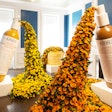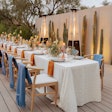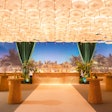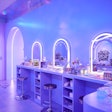
Robin Kay
Fashion Design Council of Canada (FDCC)
Title: President, FDCC, executive director of Toronto Fashion Week
What She Does: Kay works with three full-time staff members and more than 200 volunteers to produce two annual Toronto Fashion Weeks, each with 30 to 40 fashion shows.
Career Path: After starting out as a designer, in 1976 Kay opened Robin Kay Designs, a high-end clothing store that eventually expanded to a chain with 18 locations. In 1999, having designed clothing for nearly 25 years and looking for a new challenge, she sold the company and founded the FDCC with the goal of raising Canada's style profile internationally. In the same year Kay started Toronto Fashion Week, which began in 1992 as Toronto's own ready-to-wear fashion shows, setting the wheels in motion for Canadian fashion designers to influence the rest of the world.
What's the biggest challenge of running a weeklong event?
Financing is our biggest challenge. All the funds raised for each Fashion Week are used to pay off the previous season's Fashion Week. That's not the way we want to operate, but we didn't start with funds in hand, so we've always been behind. Fortunately, our suppliers are understanding and have allowed us to pay our invoices six months after the showings.
In 2004, prominent Italian designer Vittorio Missoni participated in Toronto Fashion Week. How important is it to the event's success that it attracts internationally recognized designers?
That event was an interesting one. Earlier, the FDCC and the fashion council in Italy had decided to pair up and support each other. One of the results of that decision was that Missoni chose to show in Toronto rather than New York. Toronto was still bouncing back from its outbreak of SARS the year before, and the Italian council and Missoni wanted the world to know they were not afraid to come to the city. So they did—and it was a major boost for the show, which attracted more media than ever. Too bad the government didn't see the benefit and assist us with the budget, because the show was considerably more expensive than any other we've done. In any case, the city certainly benefited from Missoni's appearance.
What is Toronto Fashion Week's budget, and how does it compare to other corporate event budgets?
My budget for the entire week is often what corporate planners spend on a single night. We spend anywhere from $250,000 to $500,000 per season.
What are some of the ways your sponsors use Fashion Week to promote their corporate names and brands?
L'Or?al is our title sponsor and as such operates the media lounge. The FDCC maintains creative control, but L'Or?al has influence, and we work together. That's the kind of relationship we want to develop with outside companies. Unfortunately, we're facing the issue of sponsors bypassing the FDCC and connecting to individual designers. It's guerrilla or piggyback marketing, and it's costing us money. We raise funds to put on the shows, and we don't charge the designers, so we need all the sponsor income we can get. The companies that are supporting individual designers could just as easily support us. We have a sponsorship package that offers no end of opportunities for them to gain exposure on-site at the shows. More important, the public relations machine we've created at FDCC would generate media exposure for them that they wouldn't otherwise get. We generate a minimum of $3 million in editorial coverage per weeklong event, and that doesn't include international broadcasts. We guarantee this media coverage. Companies should realize that we are on the precipice of a fashion explosion in this country. Supporting the FDCC will help keep our designers in Canada. Unfortunately, I do not have the time needed to tackle this problem head-on; all my time is spent on Fashion Week planning and organizing. The FDCC will eventually have to make stricter guidelines and have more control over the sponsorships that develop during each week.
How do you decorate the shows?
The purpose of a fashion show is to promote sales, so we try to create an environment that is as conducive to business as possible, and the decor is extremely important. I focus on making the runway room a setting that is contemporary and forward-looking. After all, fashion can't look five minutes ago; the room shouldn't look that way either. We allow each designer to create the look of his or her own runway. For example, during a recent show, Arthur Mendonca situated the runway on the floor using a series of Persian rugs in fall colours.
What factors influence the look of your events?
Fashion trends are very important, but we don't approach event design in a way that is typical. Keep in mind that we do our spring show in the fall and our fall show at the end of winter. So I always use the colours of the season that we're in, not those of the season the show is presenting. I do this because the colours of the current season create harmony between the outdoors and the event space. I believe the media are more inclined in this environment to have a positive outlook about the show. I also think it's important to understand the mandate of the brand or company showing its fashions at the event. There is an emotion within every product, and that needs to come out in the event. To truly have a successful fashion show, you have to understand the heart and soul of the product and your client, and build from there.
Posted 11.04.05
Fashion Design Council of Canada (FDCC)
Title: President, FDCC, executive director of Toronto Fashion Week
What She Does: Kay works with three full-time staff members and more than 200 volunteers to produce two annual Toronto Fashion Weeks, each with 30 to 40 fashion shows.
Career Path: After starting out as a designer, in 1976 Kay opened Robin Kay Designs, a high-end clothing store that eventually expanded to a chain with 18 locations. In 1999, having designed clothing for nearly 25 years and looking for a new challenge, she sold the company and founded the FDCC with the goal of raising Canada's style profile internationally. In the same year Kay started Toronto Fashion Week, which began in 1992 as Toronto's own ready-to-wear fashion shows, setting the wheels in motion for Canadian fashion designers to influence the rest of the world.
What's the biggest challenge of running a weeklong event?
Financing is our biggest challenge. All the funds raised for each Fashion Week are used to pay off the previous season's Fashion Week. That's not the way we want to operate, but we didn't start with funds in hand, so we've always been behind. Fortunately, our suppliers are understanding and have allowed us to pay our invoices six months after the showings.
In 2004, prominent Italian designer Vittorio Missoni participated in Toronto Fashion Week. How important is it to the event's success that it attracts internationally recognized designers?
That event was an interesting one. Earlier, the FDCC and the fashion council in Italy had decided to pair up and support each other. One of the results of that decision was that Missoni chose to show in Toronto rather than New York. Toronto was still bouncing back from its outbreak of SARS the year before, and the Italian council and Missoni wanted the world to know they were not afraid to come to the city. So they did—and it was a major boost for the show, which attracted more media than ever. Too bad the government didn't see the benefit and assist us with the budget, because the show was considerably more expensive than any other we've done. In any case, the city certainly benefited from Missoni's appearance.
What is Toronto Fashion Week's budget, and how does it compare to other corporate event budgets?
My budget for the entire week is often what corporate planners spend on a single night. We spend anywhere from $250,000 to $500,000 per season.
What are some of the ways your sponsors use Fashion Week to promote their corporate names and brands?
L'Or?al is our title sponsor and as such operates the media lounge. The FDCC maintains creative control, but L'Or?al has influence, and we work together. That's the kind of relationship we want to develop with outside companies. Unfortunately, we're facing the issue of sponsors bypassing the FDCC and connecting to individual designers. It's guerrilla or piggyback marketing, and it's costing us money. We raise funds to put on the shows, and we don't charge the designers, so we need all the sponsor income we can get. The companies that are supporting individual designers could just as easily support us. We have a sponsorship package that offers no end of opportunities for them to gain exposure on-site at the shows. More important, the public relations machine we've created at FDCC would generate media exposure for them that they wouldn't otherwise get. We generate a minimum of $3 million in editorial coverage per weeklong event, and that doesn't include international broadcasts. We guarantee this media coverage. Companies should realize that we are on the precipice of a fashion explosion in this country. Supporting the FDCC will help keep our designers in Canada. Unfortunately, I do not have the time needed to tackle this problem head-on; all my time is spent on Fashion Week planning and organizing. The FDCC will eventually have to make stricter guidelines and have more control over the sponsorships that develop during each week.
How do you decorate the shows?
The purpose of a fashion show is to promote sales, so we try to create an environment that is as conducive to business as possible, and the decor is extremely important. I focus on making the runway room a setting that is contemporary and forward-looking. After all, fashion can't look five minutes ago; the room shouldn't look that way either. We allow each designer to create the look of his or her own runway. For example, during a recent show, Arthur Mendonca situated the runway on the floor using a series of Persian rugs in fall colours.
What factors influence the look of your events?
Fashion trends are very important, but we don't approach event design in a way that is typical. Keep in mind that we do our spring show in the fall and our fall show at the end of winter. So I always use the colours of the season that we're in, not those of the season the show is presenting. I do this because the colours of the current season create harmony between the outdoors and the event space. I believe the media are more inclined in this environment to have a positive outlook about the show. I also think it's important to understand the mandate of the brand or company showing its fashions at the event. There is an emotion within every product, and that needs to come out in the event. To truly have a successful fashion show, you have to understand the heart and soul of the product and your client, and build from there.
Posted 11.04.05



















